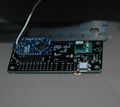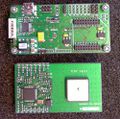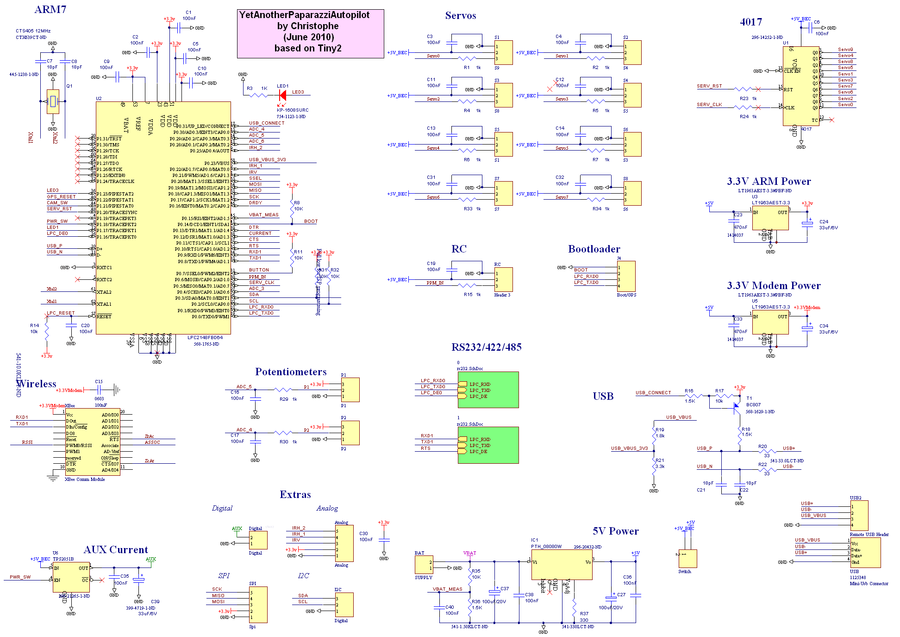Difference between revisions of "Yapa"
P0rc0 r0ss0 (talk | contribs) |
|||
| Line 1: | Line 1: | ||
"'''Y'''et '''A'''nother '''P'''aparazzi '''A'''utopilot '''v1''' and '''v2'''."<br> | "'''Y'''et '''A'''nother '''P'''aparazzi '''A'''utopilot '''v1''' and '''v2'''."<br> | ||
[[Yapa|Yapa]] is very similar to the [[ | [[Yapa|Yapa]] is very similar to the [[TWOG/v1.0|TWOG v1.0]] but has standard 100mil headers for direct standard servo connections, and has an option to put the xbee/lt2510 on the autopilot-board itself. Yapa still uses the good old LPC21 so if you are looking for the more efficient and performant STM32 you will need a [[Lisa]] | ||
''When would you use a TWOG'': | ''When would you use a TWOG'': | ||
Revision as of 02:00, 11 December 2011
"Yet Another Paparazzi Autopilot v1 and v2."
Yapa is very similar to the TWOG v1.0 but has standard 100mil headers for direct standard servo connections, and has an option to put the xbee/lt2510 on the autopilot-board itself. Yapa still uses the good old LPC21 so if you are looking for the more efficient and performant STM32 you will need a Lisa
When would you use a TWOG:
- size and weight matter
- you have a Molex Crimper
When YAPA might be useful:
- you want to use the exact same airframe file as in a TWOG
- but you want mounting holes
- or you want standard servo connectors or have high power servo's
- a few extra grams don't matter
- want to connect any serial device (from a TLL/RS232 GPS to the latest [RS422 v1 only] XSens Mti-G)
- you want to connect an rs232[/485/422 v1 only] modem or an XBee/LT2510 directly
Hardware Revision History
| Version # | Release Date | Release Notes |
|---|---|---|
| v2.00 | 02/2011 | Redesign: replaced the dual very expensive rs422/485/232 multiprotocol driver with a single rs232 and much more IO pins |
| v1.00 | 07/2010 | Initial release of Yapa v1 |
Yapa v2
- Media:yapa2.pdf Manual Only
- Media:yapa2.zip Gerbers, BOMs, Pick-Place, PDF
Sample Use [[1]]
Pinout
Pins Name and Type are specified with respect to the Autopilot Board
Features: Changelog from v1 to v2:
- 10 servo's instead of 8 (caution: standard pprz code only drives 8)
- extra ADC
- extra SPI pins
- GPS-reset
- Cam-Switch
- Remotely locatable USB (without need to unsolder the usb on the board)
- Remotely locatable XBee (or other) modem
- Resistor to select RS232 or 3.3V GPS/IMU/Modem
- 3 LED instead of 1
- More space around the mounting holes
5 Volt - Molex
Several people have asked where to find 5 Volt on yapa. The figure below shows all the power options. Here are some reasons why not all connectors have the 5V:
- yapa was specially designed to work with rs232 sensors such as XSens Mit-G/Crossbow NAV420/ig500/3DM-GX3/DMS-SGP02/MGL-sp-5 or any of such that all accept direct lipo supply
- the switching 5V is not very clean and not ideal for gps/imu (while many people use it though)
- the 5V is only present at the very top of the board and routing it accross to the bottom (gps/imu headers) would have compromised ground return paths of many signals and would have required more than 2-layer board
- the disadvantage of the 1/10th inch connectors is that they are big. To reduce the size not all pins are routed and not all power supplies are on all headers.
Other people have indicated that for some components like the GPS they prefered molex after all. While this was not the design goal there are some creative options, especially if you consider that 1.25mm pitch (molex) is nearly exactly half the 1/10th of an inch. See pictures below.
Yapa v1
Features
- Basic Design very similar to Twog_v1 (uses same autopilot configuration file 'tiny2_1_1.h')
- 100mil headers instead of the (nice and lighter) Molex connectors
- Support Holes (e.g. use M3 bobbins: [2])
- 5 x Analog 3.3V inputs with 2 of them low pass filtered
- (Optional) 2x RS232/RS422/RS485/3.3TLL serial ports for connecting virtually any serial device (if using xbee: then 1 port)
- (Optional) Onboard (optional) Xbee Modem
- 8 x PWM outputs on standard 1/10th inch headers
- 1 x R/C receiver PPM frame input
- 1 x SPI bus
- 1 x I2C bus
- 1 x USB (client) with either onboard mini-usb AND/OR remotely located USB Plug
- 2x 3.3v / 1A linear regulator for Processor and for XBee modem separated for safety
- 1 x status LEDs
- 80.0 x 40.0mm
- 23 grams including 2.4GHz Xbee Pro, all 100mil headers, usb connector, 2.5Amp 5V DCDC and serial converter
- 1 power switch with current limiter
- 2 layers PCB design, 0603 components
- (Optional) onboard 5v / 2.25A switching power supply (input voltage range 6.1v → 18v)
- 3 power options using a jumper/bridge to connect the servo power rail to the autopilot 5V power rail:
- In the case of few very low power servo's: you power your servo's from the autopilot power (not recommended: in any case check to make sure all servo's together never ever use more than 1.5 amp even when blocked)
- In the case of a high quality external BEC: you can omit the onboard regulator and power everything from the BEC.
- Otherwise: separated onboard autopilot 5V power and externally supplied servo power













